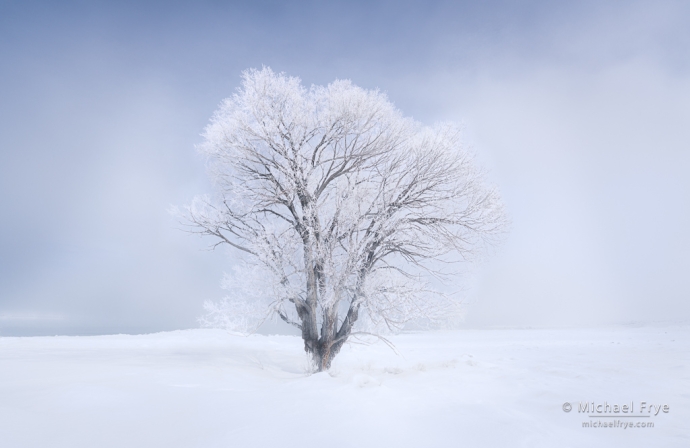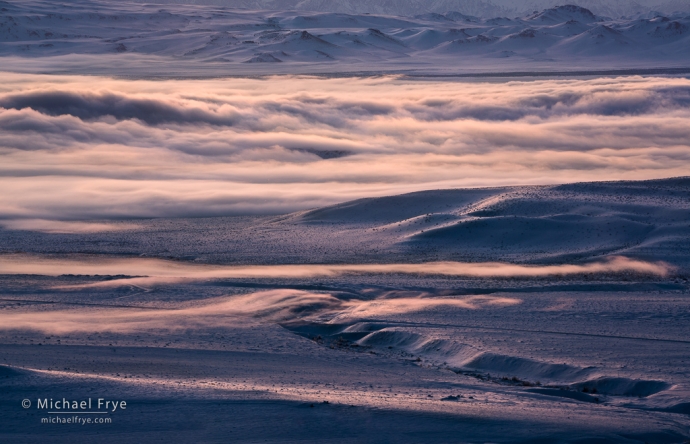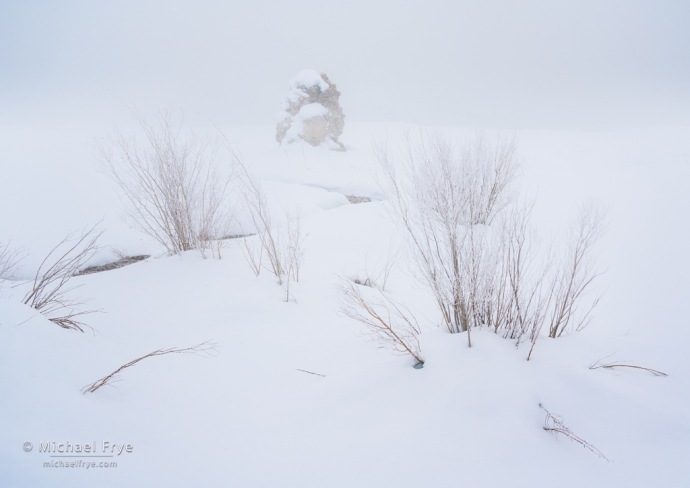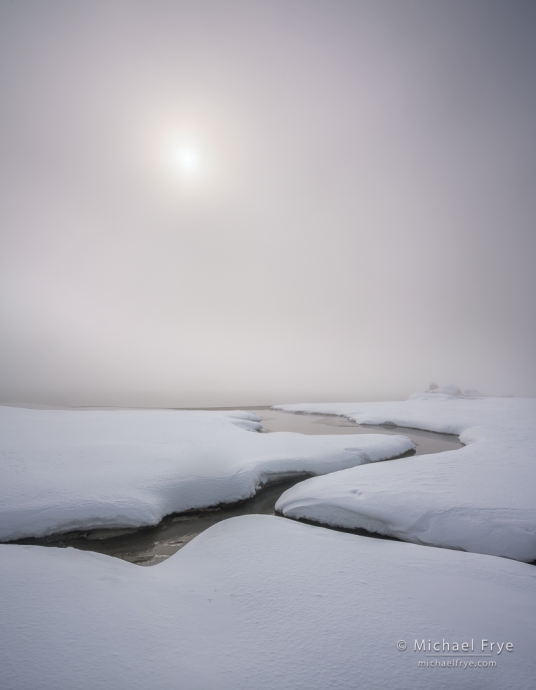In winter, Mono Lake sometimes gets socked in with fog. Locally it’s called “poconip” fog, though it’s more widely known in parts of the western U.S. as “pogonip” fog (an English corruption of a Paiute word).
The Mono Basin can get quite cold in winter. But Mono Lake never freezes, due to its high concentrations of salt. So on cold nights relatively warm, moist air rises off the surface of the lake, meets that colder surrounding air, cools, and the moisture (water vapor) condenses into microscopic water droplets, forming a low-level cloud – in other words, fog.
It’s a form of freezing fog – fog that forms at below-freezing temperatures. When freezing fog comes into contact with a surface (like a tree, fence, road, or power line ), it deposits ice crystals in the form of frost, or rime. In the Mono Basin, where freezing fog can last for days, or sometimes even weeks, frost can accumulate into layers several inches thick.
Of course I love fog, and I love Mono Lake, so naturally I’ve long wanted to photograph Mono Lake with fog. But in winter, when fog is most likely to occur, Tioga Pass is closed, turning a two-and-a-half-hour drive into a six-and-a-half-hour drive. Not exactly a spur-of-the-moment thing. And fog is always hard to predict, so it could easily turn into a long drive for nothing.
I wanted to go over there in late January, when the fog – and frost – persisted for weeks. But I couldn’t get away, and travel in that area was difficult. They got clobbered with snow in late December and early January, and the main road, Highway 395, was closed off and on during that time. Even now, more than a month after the last big snowstorm, there’s still three feet of snow along the shore of the lake, and more in Lee Vining (along the lake’s western shore). Many local roads – including the road to South Tufa – are impassible, buried in snow, and won’t be navigable until the snow melts.
But finding a break in our schedule, Claudia and I planned to head to Death Valley, and decided we could make a long detour to Mono Lake if fog seemed likely. And fog seemed possible last Monday morning, so on Sunday we made the six-and-a-half-hour drive over Carson Pass to Lee Vining and checked into our home-away-from-home at Murphey’s Motel.
I set my alarm for 5:15 a.m. It was hard to tell if there was fog at first; it was dark after all. But a closer look at the satellite imagery showed what appeared to be fog over Mono Lake. And as I looked outside a bit later the fog had reached town.
We first drove up toward Conway Summit to get a view over the fog. Then, after sunrise, we plunged back down into the murk. It was difficult getting around. Almost all the side roads we tried to explore were buried in snow. Walking over the snow was a struggle, as I frequently broke through the crust. I didn’t bring snowshoes because I hadn’t wanted to deal with them kicking around the car while we were in Death Valley, and figured the month-old snow would be firm. Clearly that was a mistake.
But I did manage to get around well enough to find some compositions I liked. The combination of snow, fog, and frost was pretty compelling. My favorite photograph from the morning is probably the cottonwood tree at the top of this post, which was actually the last image I made that day as the sun was breaking through the fog.
So I finally got to photograph the poconip fog at Mono Lake. That day was actually my birthday, and the fog was the perfect gift.
— Michael Frye
Related Posts: There’s Fog, and Then There’s Fog; Waves of Fog
Michael Frye is a professional photographer specializing in landscapes and nature. He is the author or principal photographer of The Photographer’s Guide to Yosemite, Yosemite Meditations, Yosemite Meditations for Women, Yosemite Meditations for Adventurers, and Digital Landscape Photography: In the Footsteps of Ansel Adams and the Great Masters. He has also written three eBooks: Light & Land: Landscapes in the Digital Darkroom, Exposure for Outdoor Photography, and Landscapes in Lightroom: The Essential Step-by-Step Guide. Michael has written numerous magazine articles on the art and technique of photography, and his images have been published in over thirty countries around the world. Michael has lived either in or near Yosemite National Park since 1983, currently residing just outside the park in Mariposa, California.













Really like the last one: Sun breaking through fog—
Thanks very much Glenna!
The first and the last are my favorites of this series! Glad the fog worked out for you. And Happy Belated Birthday!
Thanks for the birthday wishes Vivienne, and I’m glad you like those images!
That has got to be amazing to see! I think my favorite is Sun Breaking through the Clouds. Reminds me of childhood adventures in Vermont. Thanks for sharing your experiences. The Cottonwood is a second favorite.
Thanks so much Robin! Glad you like that image.
I too like Frosted Cottonwood and Sun Breaking through Fog. I understand the struggles through the winter months as we get in Michigan Winter Wonderland also. Sorry I missed your Birthday but Happy Belated Birthday Michael!
Thanks Randy! It can be hard to get around in winter, but it can also be beautiful if you can manage it.
Love your tree! And the series is amazing.
Thanks very much April!
Hello Michael! I just discovered your website and beautiful photographs. I lived in Bridgeport for a short time and winters are definitely beautiful…well, every season was beautiful! Thank you for sharing these pictures of Mono Lake. My favorite is of the tree. Absolutely stunning!!
Thanks Sissy – glad you found me! It’s great that you got to live in Bridgeport – such a beautiful area. I’d like to get over there more in winter, but it’s a long drive for me when Tioga Pass is closed. 🙁